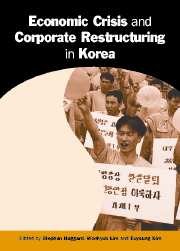Book contents
- Frontmatter
- Contents
- List of Figures
- List of Tables
- Preface and Acknowledgements
- Contributors
- A Note on Usage
- Abbreviations
- 1 Introduction: The Political Economy of Corporate Restructuring
- Part I The Politics and Economics of the Chaebol Problem
- 2 The Emergence of the Chaebol and the Origins of the Chaebol Problem
- 3 The Politics of Chaebol Reform, 1980–1997
- 4 The Government, the Chaebol and Financial Institutions before the Economic Crisis
- 5 Corporate Governance and Performance in the 1990s
- Part II The Political Economy of Crisis Management
- Part III Reform and Restructuring
- Index
3 - The Politics of Chaebol Reform, 1980–1997
Published online by Cambridge University Press: 05 July 2014
- Frontmatter
- Contents
- List of Figures
- List of Tables
- Preface and Acknowledgements
- Contributors
- A Note on Usage
- Abbreviations
- 1 Introduction: The Political Economy of Corporate Restructuring
- Part I The Politics and Economics of the Chaebol Problem
- 2 The Emergence of the Chaebol and the Origins of the Chaebol Problem
- 3 The Politics of Chaebol Reform, 1980–1997
- 4 The Government, the Chaebol and Financial Institutions before the Economic Crisis
- 5 Corporate Governance and Performance in the 1990s
- Part II The Political Economy of Crisis Management
- Part III Reform and Restructuring
- Index
Summary
Kim Dae-jung's Triple Reform: The Background
“The bubble has finally burst,” the editorial of a major newspaper, Kyounghyang Sinmun, exclaimed on December 1, 1997. Yet the great socioeconomic dislocation that accompanied the crisis also produced an outburst of reformist energy (B. Kim 2000b: 35-74). Initially forced by an agreement signed with the International Monetary Fund in 1997, reform soon won support from a wide spectrum of local political forces, and sentiment crystallized into a package which envisioned nothing less than a systemic transformation of the Korean economy.
Kim Dae-jung's era of systemic reform (1998–2003) was long awaited. Ever since a deep stagflation brought down Park Chung Hee (1961–1979), Korea's ruling political elite saw the chaebol as both a liability and an asset in its quest for economic growth and political legitimacy. The dissident (chaeya) movement had long accused the chaebol of causing social inequity and moral decay. But this ethical critique was increasingly joined by the pragmatic question of whether the chaebol way of doing business “worked.” These moral and pragmatic criticisms, coming from vastly different ideological forces on both left and right, worked together to make the chaebol a “privileged issue.”
Many of Kim Dae-jung's “five-plus-three principles” (see Chapter 6) were alterations of his predecessors’ reform policies. Despite such continuities, however, Kim Dae-jung's approach was fundamentally different from his predecessors’.
- Type
- Chapter
- Information
- Economic Crisis and Corporate Restructuring in KoreaReforming the Chaebol, pp. 53 - 78Publisher: Cambridge University PressPrint publication year: 2003
- 22
- Cited by



